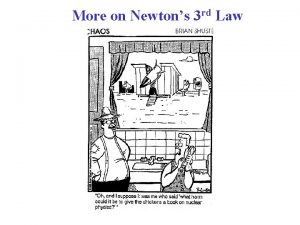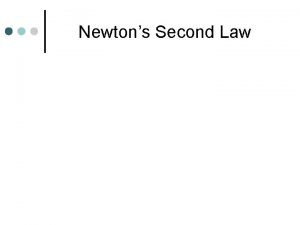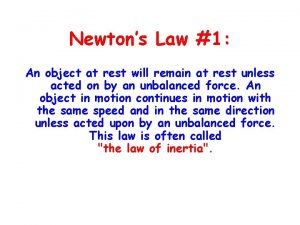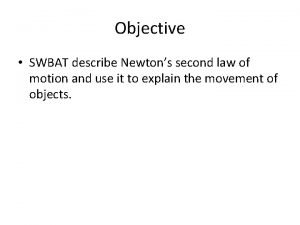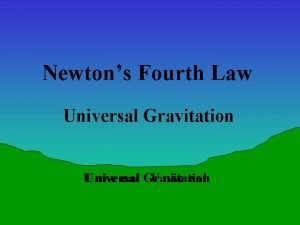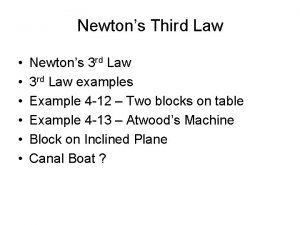Applications Examples of Newtons 2 nd Law Example










- Slides: 10

Applications & Examples of Newton’s 2 nd Law

Example 4 -11 A box of mass m = 10 kg is pulled by an attached cord along a horizontal smooth (frictionless!) surface of a table. The force exerted is FP = 40. 0 N at a 30. 0° angle as shown. Calculate: a. The acceleration of the box. b. The magnitude of the upward normal force FN exerted by the table on the box. Free Body Diagram The normal force, FN is NOT always equal & opposite to the weight!!

Example 4 -12 Two boxes are connected by a lightweight (massless!) cord & are resting on a smooth (frictionless!) table. The masses are m. A = 10 kg & m. B = 12 kg. A horizontal force FP = 40 N is applied to m. A. Calculate: a. Acceleration of the boxes. b. Tension in the cord connecting the boxes. Free Body Diagrams

Example 4 -13 (“Atwood’s Machine”) Two masses suspended over a (massless frictionless) pulley by a flexible (massless) cable is an “Atwood’s machine”. Example: elevator & counterweight. Figure: Counterweight m. C = 1000 kg. Elevator m. E = 1150 kg. Calculate a. The elevator’s acceleration. b. The tension in the cable. a a a. E = - a Free Body Diagrams a. C = a

Conceptual Example 4 -14 Advantage of a Pulley A mover is trying to lift a piano (slowly) up to a second-story apartment. He uses a rope looped over 2 pulleys. What force must he exert on the rope to slowly lift the piano’s mg = 2000 -N weight? mg = 2000 N Free Body Diagram

Example 4 -15 = 300 N Newton’s 3 rd Law FBR = -FRB, FCR = -FRC FRBx = -FRBcosθ FRBy = -FRBsinθ FRCx = FRCcosθ FRCy = -FRCsinθ

Example: Accelerometer A small mass m hangs from a thin string & can swing like a pendulum. You attach it above the window of your car as shown. What angle does the string make a. When the car accelerates at a constant a = 1. 20 m/s 2. b. When the car moves at constant velocity, v = 90 km/h? Free Body Diagram

General Approach to Problem Solving 1. Read the problem carefully; then read it again. 2. Draw a sketch, then a free-body diagram. 3. Choose a convenient coordinate system. 4. List the known & unknown quantities; find relationships between the knowns & the unknowns. 5. Estimate the answer. 6. Solve the problem without putting in any numbers (algebraically); once you are satisfied, put the numbers in. 7. Keep track of dimensions. 8. Make sure your answer is REASONABLE!

Problem 25 FT 1 a m 1 g FT 2 Take up as positive. FT 2 a m 2 g Newton’s 2 nd Law ∑F = ma (y direction) for EACH bucket separately!!! m 1 = m 2 = 3. 2 kg m 1 g = m 2 g = 31. 4 N Bucket 1: FT 1 - FT 2 - m 1 g = m 1 a Bucket 2: FT 2 - m 2 g = m 2 a

Problem 29 Take up as positive. Newton’s 2 nd Law: ∑F = ma (y direction) on woman + bucket! FT m = 65 kg, mg = 637 N FT FP a a mg FT + FT - mg = ma 2 FT - mg = ma Also, Newton’s 3 rd Law: FP = - F T


